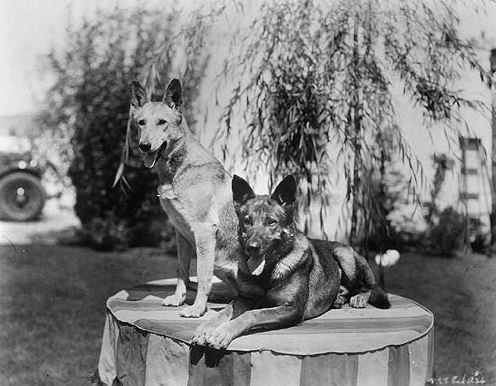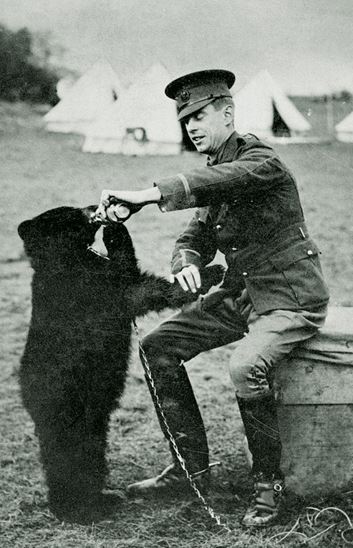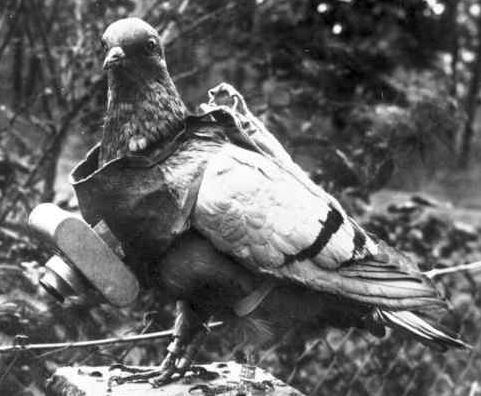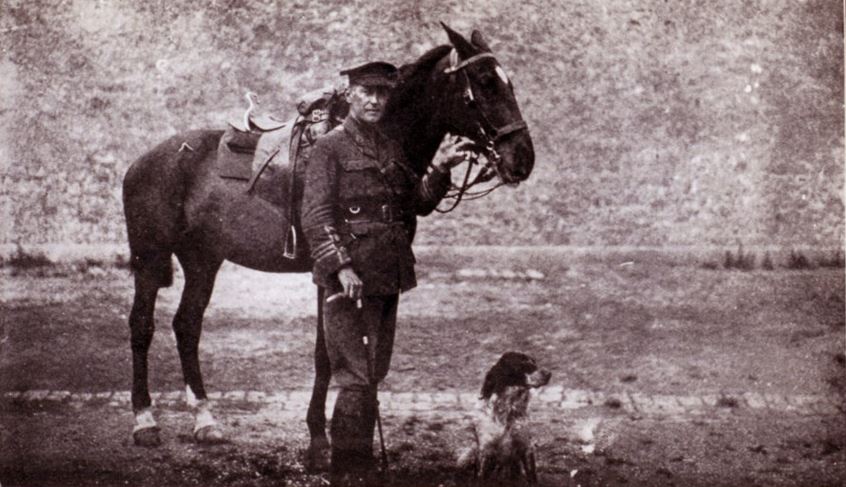Lady Saskatoon
When Arthur Buck enlisted in Lake Saskatoon in 1915, he donated a little brown bear – who was dubbed ‘Lady Saskatoon’ – for the company’s mascot. Unfortunately, no mention has been found of the little bear’s war experience.


Rin Tin Tin & Nanette
These two German Shepherd puppies were rescued in France by an American corporal in 1918. He named them after the very popular French good luck charms, Rintintin and Nenette. Rin Tin Tin became a television star in the USA after the war, as did some of his descendants.

Rin Tin Tin, right, and his litter mate Nanette at a U.S. Army base in France shortly after Lee Duncan rescued them.
Source: National Museum of American History
Image Source: Pittsburgh Post Gazette
Winnipeg
Known as “Winnie”, this black bear cub was bought by Canadian cavalry veterinarian, Harry Colebourn, on his way to Valcartier. The cub accompanied Colebourn to England, where she resided at London Zoo. It was “Winnie” who was the inspiration for Winnie-the-Pooh.

Source: Wikipedia – Winnipeg
Cher Ami
Cher Ami was a carrier pigeon who was awarded the Croix de Guerre. On October 3, 1918, she saved the lives of 194 American soldiers by delivering her urgent message to headquarters despite having been shot through the breast, blinded in one eye, and losing a leg.

Source: Wikipedia – Cher Ami
Image Source: Chemung County Library District
Simpson’s donkeys
During the Gallipoli campaign, Australian John Simpson spent three and a half weeks fearlessly transporting wounded soldiers on the backs of donkeys. He used at least five different donkeys, named “Duffy No. 1”, “Duffy No. 2”, “Murphy”, “Queen Elizabeth”, and “Abdul”. Simpson’s work was often done under fire, which led to his death on May 19, 1915.

Source: Wikipedia – John Simpson Kirkpatrick
Bonfire & Bonneau
John McCrae, the author of “In Flanders Fields”, was deeply affected by his war experiences. To assuage his grief, he spent long hours riding his horse, Bonfire, around the French countryside. His other special companion was his spaniel, Bonneau. Bonneau often accompanied McCrae while he made his rounds at the hospital.

Source: Veterans Affairs Canada
Image Source: Canada’s Great War Album
Lestock
On their journey across Canada, and ultimately to Europe, the 49th Battalion stopped in Lestock, Saskatchewan. There, a well-wisher gave the men a coyote pup. They adopted him as their mascot and named him after the town. Today Lestock’s face appears in the centre of the unit’s badge.

Source: Loyal Edmonton Regiment Military Museum
Nan
Nan, a white goat, was the mascot of the 21st Battalion. She was known throughout Belgium and France, and became the first mascot to cross the Rhine in 1918.

Source: The 21st Battalion CEF
Togo
Little is known about Togo the cat, but the photo of him sitting inside an enormous gun on the HMS Dreadnought is quite famous. Ship’s cats were, of course, very useful for rodent control.

Source: BuzzGiraffe
Percy
This black cat belonged to the crew of the tank Daphne. Percy went into action with Harry Drader, one of the crew, who was later awarded the Military Cross. Percy became famous for being in the 1917 war film entitled “The Battle of the Ancre and the Advance of the Tanks”. After the war, Percy resided at the Drader home.

Source: First Tank Crews
Image Source: Cats, Chaos, & Confusion
